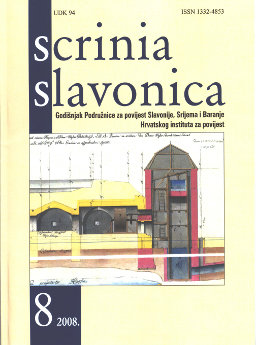Hrvatska historiografija o Požegi i Požeškoj županiji u razvijenom i kasnom srednjem vijeku
Croatian historiography about Požega and the Požega county in the High and Late Middle Ages
Author(s): Borislav GrginSubject(s): History
Published by: Hrvatski institut za povijest
Keywords: Town of Požega; County of Požega; Middle Ages; historiography; overview.
Summary/Abstract: In this paper the author made an overview of the Croatian historiography during the last century on the Town and County of Požega in the Middle Ages. Following the literature in the diachronic perspective, he grouped the various books and articles into three groups: firstly, those that were written till the end of the World War II, secondly, the ones from the socialist period (1945-1990), and finally those that were written after 1990. The author focused his attention on the methodological concepts of various authors and some specific features of each of the above-mentioned periods in historiography. In the conclusion the author gave several suggestions how to make a step forward in the research on medieval Požega. Summarizing the achievements of Croatian historiography dealing with Požegaand the Požega County in the High and Late Middle Ages during the last century, we may state that important results in the understanding of the medieval period in Požega have been accomplished by 1945, in accordance with the methodological paradigm that had thus far been dominant. In other words, the most important sources were consulted, the events more or less successfully reconstructed, and basic facts and interpretations presented. The period between 1945 and 1990 was a time of a standstill in the development of the studies of the medieval period in Požega, with rare exceptions such as Josip Adamèek, Anðela Horvat and Nada Klaiæ, not so much in terms of the amount of works and the subjects that were opened, but in terms of methodological approach, which largely remained at the same level as in the first half of the 20th century. New topics and problems of the medieval period in Požega, with new methodological approaches, started to be opened only after 1990 by members of the middle and younger generation of Croatian historians. We can expect the research to continue and intensify along the same lines. Solid bases have already been laid, which is the merit of older generations of historians and scholars of related disciplines. The results of the Hungarian historiography, which the limited space prevented us from discussing here, are a special subject associated with the medieval period in Požega. Today many authors, from Gy. Fejér and D. Csánki to P. Engel, cannot be bypassed in any serious study of the medieval period in Požega. In addition to numerous similarities with our authors, there are certain specific characteristics in the emphases of the Hungarian historians, in part derived from the different starting points of the two historiographies discussing processes within common history. A fruitful discussion and an exchange of opinions with Hungarian colleagues should be one of the ways to deepen and modernize the understandings of our historiography about the history of the Požega region in the Middle Ages. It is the task of this generation of Croatian historians and of the generations to come.
Journal: Scrinia Slavonica
- Issue Year: 2008
- Issue No: 8
- Page Range: 113-132
- Page Count: 20
- Language: Croatian

